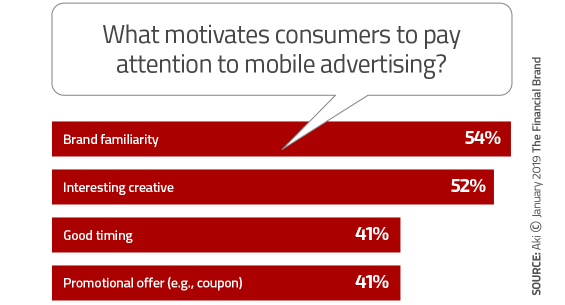Nine out of ten U.S. adults own a smartphone and 58% own tablets. One out of five Americans are “smartphone only” internet users. Obviously marketing in mobile channels should be part of every financial institution’s advertising strategy.
According to a report by eMarketer digital advertising is growing at a rate where its share of ad dollars in the U.S. will surpass traditional media. Near the end of 2018, nearly half of all advertising budgets consisted of two components: mobile advertising (34%) and desktop/laptop advertising (16%). eMarketer projects that by the end of 2020, mobile’s share of U.S. ad dollars will increase at a blistering pace, growing to just about half (49)%, a rise of over 40% in just two years.
Marketing for financial services accounted for $1 out of every $8 spent on digital advertising. This compares to the leader — retailing — at 21.9%, but is far ahead of some other industries such as telecommunications, travel, computing and consumer electronics, and media.
According to eMarketer, advertising inside apps are particularly hot — e..g., ads placed within digital audio apps like Pandora, video apps like YouTube, and social media apps. These types of ads been gaining ground over ads placed on mobile websites. By the end of 2019 eMarketer expects over four out of five mobile ad dollars will go to in-app marketing.

Navigating the Role of AI in Financial Institutions
83% of FI leaders agree investing in AI is essential for 2024 but how you leverage AI is instrumental in success and meeting customer expectations.
Read More about Navigating the Role of AI in Financial Institutions

Move the Needle from Attrition to Acquisition
Vericast’s 2024 Financial TrendWatch explores seven of today’s most critical financial services trends to provide a complete view of the current loyalty landscape.
Read More about Move the Needle from Attrition to Acquisition
Delivering Mobile Ads During High-Receptivity Periods
As more players compete for eyeballs in a seemingly endless stream of options, and as more financial institutions increasingly leverage mobile advertising, it’s critical that they improve its reach and effectiveness.
A survey of U.S. consumers by Aki Technologies probed when and where consumers say they are most receptive to mobile advertising. The research uncovered both broad trends and generational differences.
Aki suggests that marketers’ best response to the two levels of receptivity is tailoring messages appropriately, not attempting to force feed something that users can’t absorb.
“Deliver ads that cater to the more distracted mindset, like simple reminder banners with branch locators,” Aki advises.
Aki’s survey asked about receptivity to messages at specific times and states. Naturally when people are on the go they are going to be less receptive to mobile ads — obviously no one should be looking at ads while driving or walking. But overall, 51% of all respondents said they were receptive to advertising delivered while in bed — 73% of Gen Z respondents would look at ads in bed vs. 63% of Millennials, 51% of Gen X, and only 40% of Boomers.
While watching TV, overall 59% of those surveyed would be open to mobile advertising, but this was highest among Millennials at 66%. Receptivity to mobile ads while watching TV was markedly lower for Gen Z (55%), Gen X (57%), and Boomers (53%).
Much less popular was mobile advertising at mealtime. Overall only 36% said they were open to it, but 47% of Gen Z didn’t mind. People may eat with their smartphones in hand, but they aren’t necessarily looking for commercial interruptions.
Somewhat surprisingly, even less enthusiasm was expressed for receiving mobile advertising while shopping (25%),. This was followed by exercising (24%), and running errands (21%).
Aki’s advice is determine what age group is your prime target, and target accordingly with personalized campaigns.
Targeting With Data and AI
Finding the right times for mobile marketing depends on each financial institution’s mix of information, experience, audience understanding, and technology such as artificial intelligence.
A recent report by Salesforce, calls data “advertising’s north star,” saying that nearly all advertisers queried are making or planned to make much more use of demographic data to target prospects for digital promotions. The two types of data projected to see the greatest increase in adoption were data indicating areas of interest, like topics or product category, up 26%, and mobile-derived location information, up 14%.
The future of the latter opportunity may be in flux. On one hand, mobile users can themselves opt in to allow location services on their devices, even at the app level. On the other hand, Sprint recently decided to stop sharing location data with aggregators after it was revealed that one such firm would reveal individuals’ locations for a special fee. Other carriers had already implemented such policy changes, according to a report in The Wall Street Journal.
Read More: How Leading Financial Brands Are Using Digital Marketing To Win Consumers

Digital Marketing Channels to Watch
The same Salesforce report polled marketers on their adoption of four newer technologies for advertising. While none of these were tapped by a majority of those surveyed, it wasn’t that long ago that mobile devices were new territory for marketers.
- Voice-Activated Digital Assistants
- Wearable Devices
- Smart TVs
- Augmented or Virtual Reality
Wearables like smartwatches could tag onto the mobile advertising trend. According to projections by eMarketer 60.5 million Americans will use a wearable device in 2019, up close to 10% in one year. While people 25-44 dominate wearable users at present, eMarketer says the addition of more health-related features is leading to more adoption by older Americans. The research organization projects that in 2019 more than one in five internet users will be using a wearable device.








